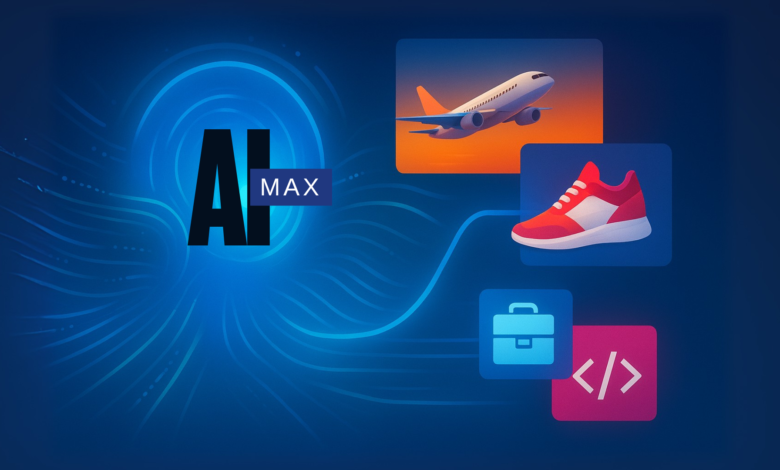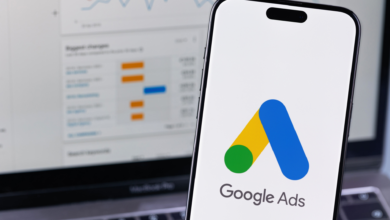AI Max Case Studies: New Analysis Reveals Key Insights

▼ Summary
– Google’s AI Max for Search campaigns combines elements of Dynamic Search Ads and Performance Max to find new customers alongside existing keywords.
– The system discovers new search terms, generates relevant ad copy, and directs users to optimal landing pages beyond manually selected keywords.
– Performance varies significantly by industry, with fashion ecommerce showing promise while B2B SaaS and travel accounts demonstrated limited impact.
– Key metrics for evaluation include conversion share versus budget allocation, cost per conversion, and identifying new high-performing search terms to add as keywords.
– Advertisers should allow a learning period for AI Max, use negative keywords to filter irrelevant traffic, and monitor overall account performance rather than isolated metrics.
Google’s AI Max for Search campaigns represents a significant evolution in how advertisers approach paid search, blending the dynamic capabilities of Performance Max with traditional search campaigns to uncover new audiences. This feature, which launched globally in late May after a private beta phase as Search Max, should achieve full availability by early third quarter of 2025. The central question for marketers is whether AI Max genuinely drives new growth or merely reallocates conversions that existing campaigns would have captured anyway.
Think of AI Max as Google merging the most effective elements from Dynamic Search Ads and Performance Max directly into standard search campaigns. Crucially, it does not replace your existing keywords but operates alongside them to identify additional potential customers. The system performs three primary functions: discovering search terms your keyword strategy might overlook through advanced matching, generating new ad headlines and descriptions aligned with actual user searches, and directing traffic to the most relevant pages on your website rather than predetermined URLs.
A major breakthrough occurred in July 2025 when Google started displaying AI Max as a distinct match type within reporting interfaces. Before this update, understanding AI Max performance felt like peering into an impenetrable black box. Now advertisers can access clear data to inform smarter strategic decisions.
When evaluating AI Max performance, begin with fundamental metrics. Navigate to your search terms report and select the option to view search terms and landing pages specifically from AI Max. This separates AI Max data from your exact match, phrase match, and broad match keyword results.
Compare conversion share against budget allocation as your first diagnostic step. If AI Max accounts for 30% of conversions but consumes 60% of your budget, this signals a potential issue requiring attention. Monitor cost per conversion as well, recognizing that initial costs may be higher while Google’s system learns what resonates with your audience.
Look beyond mere cost and prioritize conversion rates. AI Max frequently connects with ready-to-buy customers who use different search terminology than anticipated. These newly discovered search phrases can become valuable opportunities when identified patterns are leveraged effectively. One of AI Max’s most powerful benefits is uncovering search terms you never considered targeting. Filter your search terms report for AI Max queries to reveal surprising patterns – for instance, if you sell running shoes targeting “best running shoes,” AI Max might display your ads for “comfortable jogging sneakers” or “shoes for morning runs.” These represent customers seeking identical products using alternate language. The strategic response involves adding these high-performing terms to your standard keyword lists.
Identify and eliminate irrelevant traffic by monitoring search patterns. If you receive clicks from users searching for “cheap shoes” while selling premium products, immediately add “cheap” as a negative keyword. AI Max respects negative keyword lists, allowing you to steer the system toward higher-quality queries.
Every artificial intelligence system requires a learning period, and AI Max follows this pattern. Plan for an initial learning phase where the first several weeks often appear expensive as Google determines optimal approaches. Don’t panic if costs increase temporarily. Track performance daily throughout the first month, expecting to see stabilization in costs and improvement in conversion rates as the system adapts. If performance continues deteriorating after three weeks, then consider adjustments.
Monitor the types of search terms AI Max identifies over time. Early results might include numerous random queries, but these should gradually become more relevant to your business objectives as the system learns.
The most common mistake involves making excessive changes too quickly. AI Max requires substantial data to function effectively, and constant modifications prevent the system from establishing patterns. That said, certain situations demand immediate action. If AI Max spends budget on completely irrelevant searches, implement negative keywords without delay. If the system creates advertisements violating brand guidelines, remove those assets promptly.
Monitor overall account performance rather than focusing exclusively on AI Max metrics. Sometimes AI Max might appear costly in isolation while actually enhancing other campaign performance by capturing different traffic segments.
Since AI Max continues evolving with Google regularly introducing new features, adapt your approach by building reporting systems capable of scaling with these changes. Establish automated reports for the metrics most critical to your business objectives. The most successful implementations come from businesses that establish clear goals, provide quality data, and allow the system to operate effectively. Your role shifts from keyword management to strategic oversight.
If you’re hesitant about implementation, begin testing AI Max on a limited scale. Create a single campaign with AI Max enabled and compare it against existing campaigns. Alternatively, run an AI Max for Search campaign experiment and allow Google to determine statistical validity. Once you understand how it performs for your specific business, you can make informed expansion decisions.
Early case studies from various industries reveal mixed results, though these represent limited data sets that shouldn’t be considered statistically significant.
In tourism and travel, an advertiser with an established search structure faced growth challenges due to intense competition and already-optimized keywords. AI Max generated additional conversions but demonstrated limited impact relative to the existing setup. The conversion rate measured substantially lower than other match types at 1.47%, though the average cost-per-click remained low at €0.11. Broad match achieved an even lower CPC of €0.09 with a conversion rate exceeding twice that of AI Max. Search term overlap analysis revealed AI Max had a 22.5% overlap rate, meaning 77.5% of queries were new to the campaign – a positive indicator for query discovery.
Fashion ecommerce showed more promising results. During the competitive holiday season when exact match keywords became increasingly expensive, AI Max delivered the lowest CPC at €0.08 with a respectable 2.15% conversion rate. Although conversion rates trailed exact and phrase match, the cheaper clicks maintained competitive acquisition costs. AI Max captured fashion-related long-tail searches and seasonal queries the existing keyword strategy had missed, outperforming broad match with both reduced costs and superior conversion rates. The system demonstrated particular strength in understanding product context and user intent within fashion’s diverse search terminology. Search term overlap analysis showed only 18.7% overlap, meaning 81.3% of queries were completely new – valuable discovery in a highly competitive market.
B2B SaaS implementation struggled despite mature conversion tracking measuring both marketing qualified leads and sales qualified leads. AI Max achieved a reasonable CPC of €0.89 but conversion rate reached just 0.76%, pushing cost per acquisition well above targets. The system tended to capture informational searches from users not prepared to convert. Even broad match outperformed AI Max with a 1.23% conversion rate at lower cost. The complexity of B2B purchasing cycles favored exact and phrase match keywords over AI Max’s broader interpretation. Search term overlap analysis showed 31.4% overlap, leaving 68.6% of queries as new – though these primarily represented low-intent informational searches misaligned with sales qualified lead objectives.
Broader industry sentiment reflects these varied outcomes. In a recent advertiser poll, over 50% of respondents reported neutral results from AI Max, while 16% observed positive performance and 28% experienced poor outcomes.
You can analyze AI Max queries in Google Sheets using straightforward formulas. If your search term report displays terms in column A and match types in column B:
To identify search terms appearing in both AI Max and other match types: =IF(AND(COUNTIFS($A:$A;A2;$B:$B;”AI Max”)>0;COUNTIFS($A:$A;A2;$B:$B;”<>AI Max”)>0);”Overlap”;”No Overlap”)
To count how many match types trigger a specific term: =COUNTIFS($A:$A;A2)
To measure query length through n-gram analysis: =(LEN(A1)-LEN(SUBSTITUTE(A1,” “,””)))+1
These analyses reveal whether AI Max surfaces unique queries, overlaps with existing match types, or favors short-tail versus long-tail terms.
Since AI Max remains in early development stages, definitive conclusions are challenging. Performance might improve as the system processes additional data, or remain stagnant if your existing setup already covers most transactional queries. This question will become clearer in coming months as more testing data emerges. Current results range from positive to neutral to negative, with neutral or negative outcomes more common in accounts with strong existing structures where AI Max has limited opportunity to add value.
To streamline AI Max analysis, a Google Ads script automatically imports data into Google Sheets for deeper examination. This automation saves considerable manual effort and incorporates the formulas mentioned earlier, enabling immediate identification of overlap rates and query patterns without manual configuration.
The script generates two worksheet tabs: AI Max containing Performance Max search term data with headlines, landing pages, and performance metrics, and Search Term Analysis providing comprehensive match type comparisons including AI Max with automated formulas. The analysis covers overlap detection between AI Max and other match types, query length assessment distinguishing short-tail from long-tail terms, match type frequency counts to identify competitive terms, and automatic cost conversion from Google’s micro format into readable currency.
Implementation involves creating a new Google Sheet and copying the URL, navigating to Tools > Scripts in Google Ads, pasting the script code while updating the SHEET_URL variable, then executing the script to automatically populate your analysis. This setup enables quick calculation of the same metrics used in the case studies – such as the 22.5% overlap rate in tourism or the 81.3% new query discovery in fashion. The automated workflow clarifies whether AI Max uncovers genuine new opportunities or simply redistributes existing traffic.
(Source: Search Engine Land)





